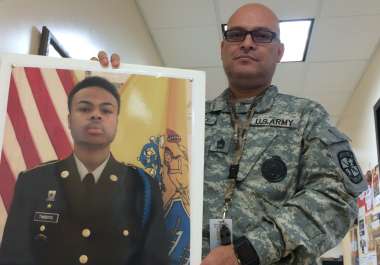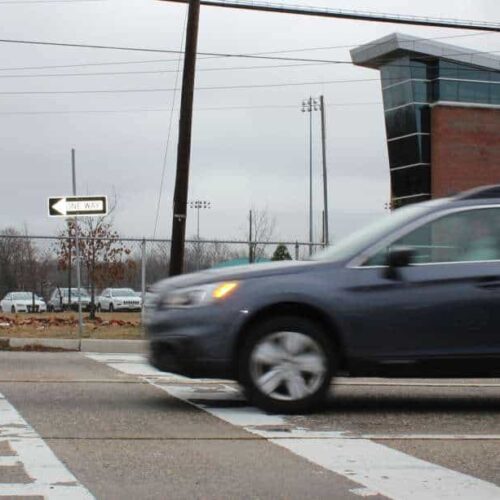Introduction
BURLINGTON, New Jersey — The health hazard posed by traffic is invisible. The safety hazard is all too obvious, especially here.
Nearly 8,000 U.S. public schools sit close to busy roads, and in some cases, students must cross those lanes to get to class. In Burlington, northeast of Philadelphia, hundreds of students walk across a road the nonprofit Tri-State Transportation Campaign calls the most treacherous for pedestrians in all of New Jersey.
A four-year-old on the way home from after-school care was killed in 2008 on the road, the six-lane Route 130. A 12-year-old was badly injured in 2012 while riding his bike across it. And last May, a 17-year-old sophomore who didn’t even have a foot on the road was fatally struck by a driver who ran off the pavement.
“Our students are walking across this road to get to not only our schools but almost everywhere they need to go in Burlington City,” said Burlington City High School Principal Jim Flynn, whose office looks out onto Route 130. “This very dangerous road divides us.”
Now, it’s mobilized them. Horrified about the death of sophomore Antwan Timbers Jr., his classmates have campaigned all school year for drivers to slow down, inspiring a state senator to propose a lower speed limit and other safety-minded changes.

It’s a local piece of a nationwide transportation challenge. About 100 children are killed every year while walking or biking during the times of day kids typically go to and from school, according to the National Highway Traffic Safety Administration.
Nine years ago, New Jersey enacted a law to try to stop schools being built near highway ramps, and vice versa, after the death of an 8-year-old boy outside his Newark elementary school in 1997. But it’s arterials — roads like Route 130 — that are the most deadly for walkers, in New Jersey and nationwide.
Lowering speeds around schools is one way to reduce crashes and deaths throughout the day, not just immediately before and after class, the Safe Routes to School National Partnership says.
In Burlington, an enclave of 10,000 that gets more than three times as much traffic on its main route, students and teachers want the speed limit permanently lowered from 40 miles per hour to 25. That’s the speed motorists are supposed drive for a few hours in the morning and afternoon when kids are most likely to be walking to and from school, but the temporary limit isn’t working.
When a group of students and staff clocked speeds with a radar gun one morning last fall, “nobody was going 25,” said junior Jesseca Lamont, 16. “Some people were going 50, 60 miles per hour.”
Students are also coming and going from the high school after hours and on weekends, when the crossing guards aren’t out and the 40 mph limit applies. Flynn said fifth- and sixth-graders cross Route 130 to get to football practice in late afternoons, and he routinely sees kids walking across the road in the dark.
The route is divided as it cuts past the Burlington schools, with stores tucked between the north- and southbound lanes. It’s as if students must navigate two roads rather than one, with twice the opportunities for harm.
Students have held a rally, made a presentation at City Hall, researched the life-and-death implications of crashes at different speeds and produced a safety video. In January they testified at a hearing on state Sen. Diane Allen’s legislation.
“If you would go to any student in any grade, they would be like, ‘Oh, Antwan, he’s an amazing friend,’ ” said Jesseca, who knew him well as a fellow cadet in the school’s Junior Reserve Officers’ Training Corps, and who is best friends with the young man injured on the road in 2012. “We don’t want another tragic incident.”
Hopkins reported this story with the support of the Dennis A. Hunt Fund for Health Journalism and the National Fellowship, programs of the University of Southern California Center for Health Journalism.
Read more in Environment
Carbon Wars
A California regulator’s curious crusade to remake the Clean Air Act
In the smoggy San Joaquin Valley, an air pollution control officer is under fire for aiding members of Congress who want to weaken the law
Carbon Wars
The invisible hazard afflicting thousands of schools
Across the country, in big cities and small towns, kids attend schools so close to busy roads that traffic exhaust poses a health risk



Join the conversation
Show Comments